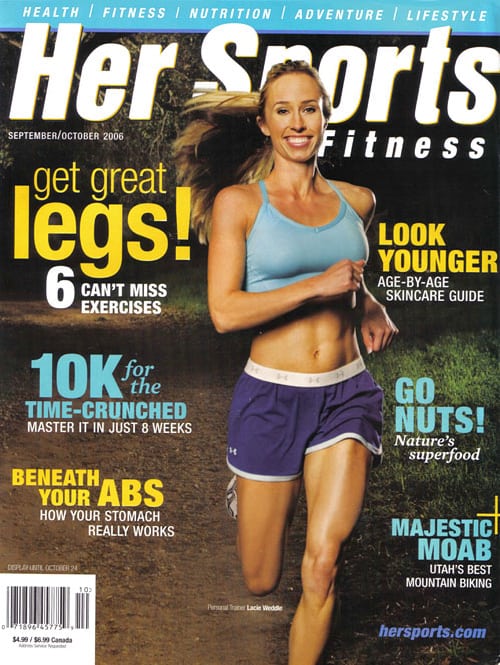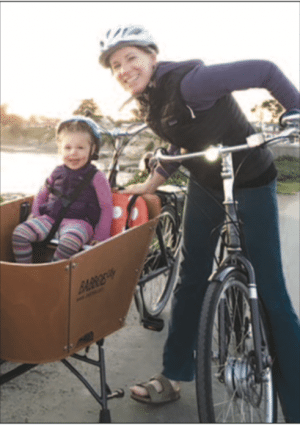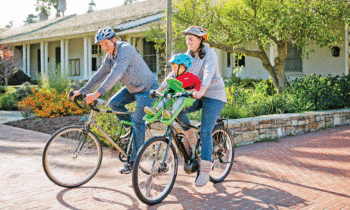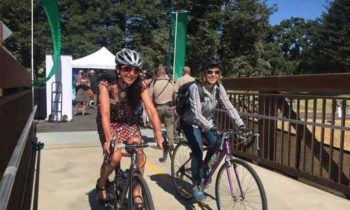Part mountain biking, part road cyling, cyclo-cross racing takes you for a ride on the wild side.
September/October 2006
Her Sports Fitness
By Karen Kefauver
The first time I saw a cyclo-cross race it was pouring rain on a chilly December afternoon in northern California. I expected the race to be canceled, but despite the downpour, the cyclists charged through puddles, ran up bumpy hills and pedaled fast over paved surfaces. Inspired by my friend’s smiling, muddy face, I signed up for my first cyclo-cross race the next weekend. I muscled through a fun, fast 40-minutes of jumping on and off the bike, lifting it over 12-inch wooden barricades and running for short spurts.
Cyclo-cross originated in Europe about 60 years ago as a way for road cyclists to stay in shape during the off-season. Lately, it’s enjoyed growing popularity in the United States. “We’ve seen an increase in both the number of competitors and events over the past few years,” said Andy Lee, spokesman for USA Cycling.
‘Cross, as it’s called, differs from other cycling races primarily because riders get off their bikes and hurdle various obstacles, both natural and manmade. Typically, a ‘cross racer will dismount and remount multiple times during each lap around the 1.5-mile, mostly off-road course. The cyclist who completes the most laps in a preset time wins the race.
Although cyclo-cross races last only about an hour or less, they’ll put both your aerobic endurance and bike-handling skills to the test. And thanks to spectator-friendly courses, spirited crowds gather inches from the action and will cheer you on the whole way. As for rain, mud, snow and ice—the more, the better.
If you’re ready to tackle cyclo-cross, these tips will help get you ready to roll.
Run. Include running in your training routine, especially some speed and hill work. This will not only build your aerobic endurance, but also help you charge up steep hills, called “run-ups” in ‘cross-speak.
Pace yourself. While the races take less time than other endurance events, like triathlon, the intensity is high with all the getting on and off the bike, clearing obstacles, running in bursts and pedaling fast. But don’t feel pressured to start riding too quickly, and monitor your effort so you don’t overdo it.
Practice mount/dismount. To avoid having to come to a full stop every time you get off your bike, practice a “rolling dismount.” Coasting slowly on a flat surface, stand up on your pedals, swing your right leg back over the frame and bring it to the other side between the bike and your left foot. Unclip your left foot from the pedal and start running, right foot first. To remount, push the bike forward, grasping the handlebars with both hands, and in one motion, throw your right leg back over, hop onto the seat, and place both feet on the pedals simultaneously. Always dismount/remount on the left side to avoid contact with the chain ring.
Have a hydration plan. Cyclo-cross racers don’t have bottle holders on their bikes or wear hydration packs (a sure sign of a newbie). These things can get in the way of hoisting the bike and getting over obstacles. Instead, ‘cross races usually have feed zones where racers ride by and grab bottles for a quick gulp, and then toss them to the ground for someone to retrieve and refill for the next lap. So, recruit a buddy to help you keep hydrated. You may even want to practice slowing down and grabbing the bottle from your friend beforehand to ensure you don’t miss the hand-off.
Watch and learn. In ‘cross races you usually get a warm-up lap. Use this time to learn from more skilled riders. Scope out a pro or more experienced racer and try to follow her. As you ride around the lap, notice what line she takes (choosing the most direct route is part of the strategy of ‘cross racing) and observe how she dismounts/ remounts, picks up her bike and handles the obstacles and hills. If you can’t keep up, then plant yourself in front of a “run-up” or other major hurdle and watch how others tackle it.
Walk the hills. Short but steep hills are standard features on ‘cross courses. Experienced cyclists will run up these inclines carrying their bikes, or even ride up them. But beginners should moderate their efforts. Push the bike up the hills rather than carry it, and walk rather than run.
Be considerate. In cyclo-cross you’re allowed to pass on the right and the left, unlike road races in which you have to keep left. So, call out “On your left!” or “On your right!” to signal that you’re about to pass. And if you’re being passed, try to yield by slowing down and moving off to one side of the path.
Stay focused. With cyclists surrounding you and cheering crowds so close, it’s easy to get distracted. Keep your eye on the trail to scan ahead for obstacles and riders who might stop abruptly in your path.
Cyclo-Cross Resources
To learn more about he sport of cyclo-cross or locate events in your area, visit:
CYCLOCROSSWORLD.COM Race coverage, tips, online store of cyclo-cross clothing, equipment and accessories
USACYCLING.ORG/CX the cyclo-cross site of the official cycling organization of the United States
NCNCA.ORG the Northern California and Nevada Cycling Association’s site, with a calendar of nationwide events and extensive list of resources.
CYCLE-SMART.COM Training tips and coaching services from cyclo-cross specialist Adam Myerson.
Gearing Up
Bicycle. A cyclo-cross course is mostly off-road, so you’ll want to start out on a mountain bike, with its thicker tires and shock-absorbing suspension, even though the relatively heavy frame and tires will slow your progress I going uphill and make lifting it over barriers more difficult. After a few races, if you find you’re hooked on ‘cross, consider getting a cyclo-cross bike, which is specially adapted to the sport. Usually made of lightweight aluminum or steel for durability, cyclo-cross bikes have dropped handlebars, like on a road bike, offering better control and more hand positions than the straight bars of a mountain bike. The tires (700 x 32mm) are thinner than mountain bike tires, but thicker than those of a road bike. A ‘cross bike also has cantilever brakes, which work well in mud. Major manufacturers include Trek, Cannondale, Ritchie and Redline, with bikes starting around $900.
Shoes and pedals. Cyclo-cross racers prefer a clipless pedal system, which involves stiff-soled, cycling-specific shoes with cleats that secure the foot to the pedal. They’re a bit of a hassle to get out of when you have to dismount, but the trade-off is worth the power and efficiency you’ll gain the rest of the race by wearing them. Choose mountain bike shoes over road-cycling shoes. The recessed cleats and tread of mountain bike shoes will help you scramble up the hills and over obstacles when you’re off the bike. (Road cycling shoes are difficult to walk in, much less run in.) If you don’t have a clipless system or prefer simple platform pedals, then wear mountain bike shoes without the cleats. Don’t use clips or toe cages, however; they’ll make it difficult to get in and out of the pedals fast.
Helmet. A cycling helmet is a must. Make sure it’s comfortable, has good ventilation and adjustable straps. Generally the more expensive models, $100 and more, are lighter weight and have more vents. For cold days, wear a snug-fitting hat under your helmet.
Gloves. To protect your hands in case of a fall and minimize chafing, wear cycling gloves. Long-fingered ones are standard for the winter racing season, but short-fingers are more comfortable if weather permits. Gel-filled gloves provide an extra layer of cushioning.
Clothing. Wear cycling shorts. You’ll need the padding to cushion the often bumpy ride. And remember, skip the underwear. Cycling shorts are designed to be worn alone. Wearing an additional layer underneath them will cause chafing. Don’t wear baggy mountain bike shorts, which can catch on the bike saddle or handlebars when you get on and off your bike. On the top, wear a cycling jersey or any other snug-fitting shirt made of sweat-wicking material.
Karen Kefauver is a freelance writer based in Santa Cruz, Calif. She started cyclo-cross racing in 2000 and has been reporting on the sport since 1994. She can be contacted at [email protected]







